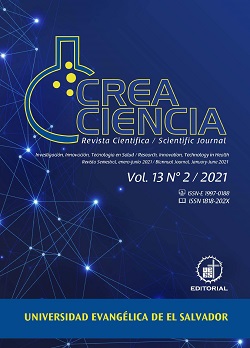Isolation and identification of the mold that causes anthracnose in musa paradisiaca l. (plantain) in cooperative san carlos, el salvador and isolation of molds and yeasts with antagonistic capacit
DOI:
https://doi.org/10.5377/creaciencia.v13i2.11825Keywords:
Fungi, Yeast, Fusarium dimerum, antagonistAbstract
Anthracnose is a disease caused by a variety of fungi, the species to vary according to the weather and environmental conditions of each country, this disease affects the banana fruits by reducing their quality and shelf life and as consequence they cause losses for farmers In El Salvador this disease is control with pesticides that pollute the environment and expose the health of the workers and consumers. The few studies under in El Salvador about the identity of the fungi that affect the bananas with this disease reduce the possibility of implementing alternatives of control for this disease. This investigation focused on the isolation and identification of the fungus causing anthracnose with higher pathogenicity, the study was carried out in banana plantations of Cooperativa San Carlos El Paisnal, El Salvador. The ability of the isolates to cause lesions in banana fruit was demonstrated and, from the values obtained, the microorganism with the highest pathogenicity was selected and a molecular identification was made, obtaining as a result that the disease is caused by the species of Fusarium dimerum. Also, isolation of fungi candidates for antagonists was carried out, and was isolated a yeast with a capacity of 100% inhibitory for the pathogenic species Fusarium dimerum.
Downloads
810
Downloads
Published
How to Cite
Issue
Section
License
© Crea Ciencia
Declaration of originality and assignment of rights
The article must be sent with a declaration of originality, responsibility and assignment of rights of copy of the manuscript, scanned and signed by the author or by one of the authors when the authorship is collective (designated author), stating that the text has not previously published in printed or electronic format, which will not be presented to any other media before knowing the decision of the journal Crea Ciencia and that, if accepted for publication, the authors transfer the copyrights in all forms and media known. At the end of six months of the publication, the text can be shared in another magazine citing the first version of the article published in Crea Ciencia and recording its number and volume. If the article is not published, the UEES agrees to return the rights enunciated to their authors.

Crea Ciencia articles are published in open access and licensed under a Creative Commons Attribution-NonCommercial 4.0 International License.

